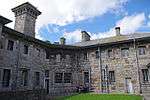Beaumaris Gaol

Beaumaris Gaol is a disused jail located in Beaumaris, Anglesey, Wales. Although no longer in use it remains largely unaltered and is now a museum open to visitors, with around 30,000 visiting each year.
History
The jail was designed by Hansom and Welch, and was built in 1829.[1][2] It was expanded in 1867 to accommodate approximately 30 inmates but was closed just 11 years later. The building then became a police station until the 1950s when it became, oddly, a children's clinic and lastly a museum in 1974. During the Second World War the town's air raid siren was located in the gaol and was kept in operation during the Cold War in case of nuclear attacks. The gaol's chapel is not original to the building, and the pews and pulpit were sourced from a chapel being renovated elsewhere on the island. It is possible to tell that the pews are not the original ones as the numbering sequence is out of order and they are not fixed to the floor.
The prison regime may appear brutal to a modern visitor, but in its day it was seen as humane improvement on earlier gaols. Even so, methods of keeping criminals in check included chains, whippings and isolation in a dark cell for up to three days. It has one of the last working treadmills in Britain. The treadmill at Beaumaris is unusual in that it pumped water to the top of the building for use in the cells, meaning that the prisoners were not forced to work for no reason.
Executions
Only two hangings took place at Beaumaris. The first was that of William Griffith, in 1830, for the attempted murder of his first wife. He reacted badly to the news that he was to hang and on the morning of his execution, barricaded himself inside the cell. The door was eventually forced open and he was half dragged and half carried to the gallows. The second and final execution was that of Richard Rowlands in 1862, having been found guilty of murdering his father in law. He protested his innocence right up to the final moment and legend has is that he cursed the church clock from the gallows, saying that if he were innocent the four faces of the nearby church clock would never show the same time. Indeed, for a while they did not, although this has been attributed to the wind buffeting the southern face. Both men were buried in within the walls of the gaol in a lime pit, but the exact location of their burial is unknown. The metal rivets which held the gallows in place, along with the two doors which the condemned man passed through can still be seen from the street outside the Gaol walls.
Escapes
Throughout its time as a gaol there was only one instance of a prisoner escaping. The prisoner, John Morris, escaped on 7 January 1859, using rope he had stolen whilst working with it. Although he broke his leg whilst escaping he did make it out of the town, before being recaptured.
Alleged hauntings
The TV series Most Haunted visited the gaol for a show aired 17 January 2007 to investigate supposed hauntings.
References
- ↑ Davies, John; Jenkins, Nigel (2008). The Welsh Academy Encyclopaedia of Wales. Cardiff: University of Wales Press. p. 713. ISBN 978-0-7083-1953-6.
- ↑ Harris, Penelope, "The Architectural Achievement of Joseph Aloysius Hansom (1803-1882), Designer of the Hansom Cab, Birmingham Town Hall and Churches of the Catholic Revival", The Edwin Mellen Press, 2010, ISBN 0-7734-3851-3, p.13.
External links
- Beaumaris Gaol - Visiting information from the Isle of Anglesey County Council
Coordinates: 53°15′48″N 4°05′42″W / 53.2633°N 4.0951°W